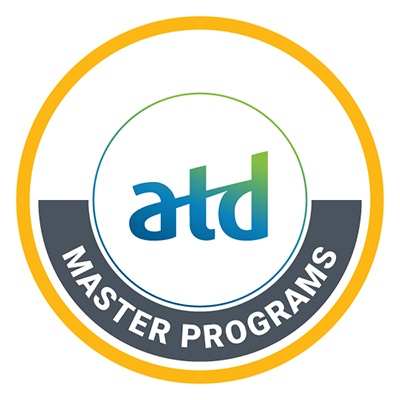ATD Blog
Elevate Your Professional Development
Tue May 23 2023

Lean on your cohort to support your growth in ATD’s Master Trainer Program

There’s a reason why ATD’s comprehensive training delivery program, Master Trainer, has its name: It’s about mastery. Aligned with the Talent Development Capability Model, the Master Trainer program provides enrollees with the skills and opportunities to practice them in such areas as presentation, applying adult learning principles, selecting methods to address learner motivation, the ability to create stories and analogies, and the capacity to evaluate training to align to business outcomes.
Recently updated, the Master Trainer program is a blended eight-week course leveraging ATD’s new digital learning platform, which provides a cohesive digital experience for participants featuring all the learning content across the blended design, explains Darryl Wyles, senior facilitator in ATD’s education department. As to the course and what it takes to become a Master Trainer, learners get an “idea of the size, scope, and importance immediately,” says Wyles.
During the first three weeks of the program, participants engage asynchronously with each other and the facilitator online, completing assignments that prepare them for a week of live online or face-to-face learning. This is an enhanced experience from the earlier format, Wyles notes, where deliverables were only a requisite of the final part of the program.
Just as challenging as the earlier iteration of Master Trainer, the current blended learning program features a more engaging, learner-centric approach that offers participants feedback sooner in the course and enables the facilitator to tailor the in-person portion of the program based on feedback and progress in the asynchronous portion. For example, if the facilitator noticed either strengths or areas for learner development, they could spend less or more or time accordingly during in-person coursework.
The small class size and the format, shares Wyles, creates a collaborative environment. To be successful, participants need to lean on one another, producing a strong sense of camaraderie among each cohort of learners. That’s a key part of the course’s secret sauce, he explains.
Our field is all about adapting, notes Wyles. “Adapting to the moment, to the ever-evolving environments that we’re supporting. The program is a great model \[because\] it’s constantly challenging participants to fully use their skill set and the relationships they’re developing within their cohort. That’s what TD professionals aim to do every day.”
People walk away from this program with clarity, emphasizes Wyles. After successfully completing the program, trainers have the knowledge, skills, practice, and resources to continue their professional development.
Wyles himself became a Master Trainer via the prior format—so he has unique insight into the program’s enhancements. Queried about the upskilling he needed to prepare to facilitate in the new format, Wyles shares that many trainers are comfortable in a face-to-face classroom environment. Therefore, the technology aspect required an adjustment, such as knowing when to communicate with learners and ensuring that he was available to each of the participants when they needed him to be.
What hasn’t changed about the program is the mastery of capabilities required to complete the program and receive an ATD Master Trainer designation. The standard is so high that it is an honor to facilitate the course, says Wyles.
You've Reached ATD Member-only Content
Become an ATD member to continue
Already a member?Sign In
